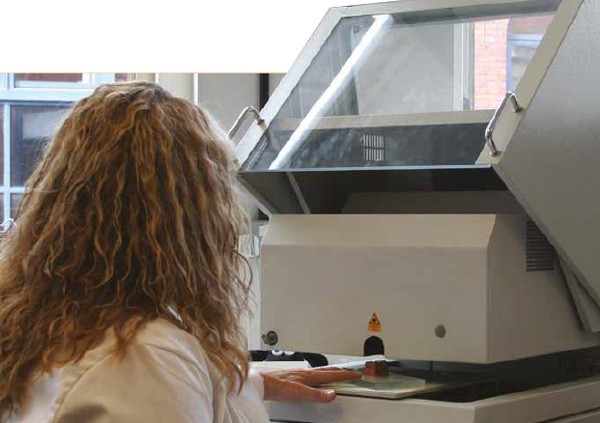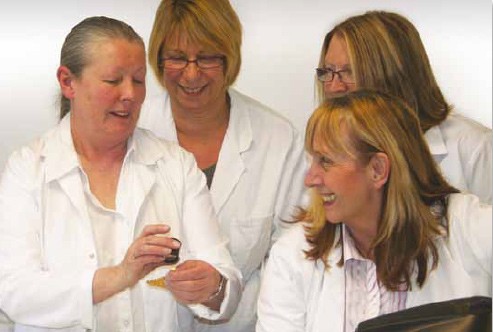Meet the Experts Bonded Gold
Bonded Gold
In a new series contributed by Assay Office Birmingham, its experts talk about the challenges which face them on a daily basis, and which require all of their knowledge and experience to resolve.

Diana Donnelly has been an assayer since 1997. Initially, Diana was trained to assess fineness by touch acid testing, prior to scraping off minute samples for assaying (testing) using the traditional methods of cupellation for gold or titration for silver. However, as imports of finished jewellery increased and domestic production of articles sent to the Assay Office in an unfinished state diminished in the late 1990s and early 2000s, the Assay Office invested in and retrained its assayers in newly developed X-ray fluorescence technology (XRF). Assaying by XRF usually requires no scraping of the articles but still delivers an accurate fineness when carried out by a skilled operator with a sophisticated machine and all of the necessary standards.
Diana is part of a team of assayers who are crucial to the hallmarking process, as it is their job to ensure that the precious metal is of the fineness declared by the supplier. Once the hallmark is applied, the Assay Office itself has guaranteed that fineness and is responsible for any error, so any mistakes are very costly. The assayers’ time is included in the hallmarking fee, so it is important that they can reach the correct conclusion quickly and efficiently.
Many items submitted for hallmarking are straightforward and only require assessment by one operator. However, the high price of gold has seen the introduction of new concepts in precious metal jewellery that have suddenly made assaying much more complicated and fraught with problems.
Diana explains: “We are quite used to seeing gold-plated silver, which is generally a sterling silver core with a thin plating of nine carat gold. That is relatively easy to identify as the XRF reads straight through the gold plating to the silver. However, we are sometimes faced with silver items, plated with a higher purity such as 18 carat gold, which can skew the result and therefore they require a much more detailed level of analysis. This also applies to products with a sterling silver core, plated with a fine silver plating. We always have to be sure we assess the silver content of the product under the fine silver plating correctly so that the appropriate hallmark is applied.
“The most recent big challenge is the trend for ‘bonded gold’, which has been developed for the US market. This has really made us think! It is normally gold laid on top of silver, but may also have a base metal core. The gold layer is much thicker than in gold-plated, or rolled gold items – usually around 10 per cent of the thickness, making it more difficult to detect the metal underneath.
“Diamond-cut bonded gold merchandise is easily detected, as the silver surface is exposed to the naked eye as a result of the diamond cutting process. But that’s not always the case. All we can usually see is the outer gold layer, so we have to assay these items very carefully to determine exactly what is underneath. Bonded gold differs from rolled gold in so far as the two layers of precious metal are actually metallurgically bonded together due to the heat and pressure used during the bonding process. Apart from that, this is a similar product to rolled gold, where the outer layer is rolled onto the silver but the two metals remain entirely separate. Most bonded gold items require a tiny surface area to be removed in order for the XRF instrument to accurately read the sterling silver content below. The surface area affected is not visible.
“We also need to assess the outer gold layer to identify what fineness it is. This is usually done by touch acid testing, confirmed by XRF, before we explore to see what is underneath. The article cannot legally be described as bonded gold if the fineness falls below the lowest acceptable gold standard in the UK, ie 375 parts per thousand (ppt) or nine carat.”
Once the assayers have determined the precious metal content, the article is passed through for hallmarking. There has been a lot of discussion as to how such products should be hallmarked, as bonded gold is not specifically mentioned in the Hallmarking Act of 1973, although rolled gold and plated gold are. There is a tendency for manufacturers in other countries with less rigorous hallmarking systems than the UK to apply 9K marks to indicate the outer coating is nine carat, but this is very misleading to the consumer. After legal consideration by the Trading Standards authorities and the British Hallmarking Council, guidance was issued in early April 2012 that the same rules must apply for bonded gold as already exist for rolled and gold plated items. Bonded gold on sterling silver items is therefore marked with a full sterling silver hallmark, but with no reference to the fineness of the gold. Bonded gold on base metal cannot carry a UK hallmark.
A gold fineness mark (not hallmark) is allowed if it is immediately preceded or followed by the words ‘bonded gold’, ‘rolled gold’ or ‘gold plated’. For example, an article with a silver hallmark (or 925 stamp on underweight articles) can be marked as follows: 925 & 18ct bonded gold/ rolled gold/gold plated. Without this additional information neither the retailer nor the consumer, nor indeed the experienced assayer, can tell by eye whether the item is bonded, rolled or plated, or what the core metal is.

Definitions
Gold plated:
An article coated with a thin layer of gold, usually by electroplating. The gold must have a fineness of at least 375ppt and is usually around 175 microns thick.
Rolled gold:
A sheet of gold of at least 375ppt standard sweated or soldered to a sheet or bar of silver or base metal. The proportion of gold alloy to the weight of the entire article is usually less than five per cent.
Bonded gold:
A sheet of gold of a standard not lower than 375ppt brazed to a sheet or bar of silver or base metal, the whole being compressed down together with a resulting thickness of around 10 per cent gold alloy. Heat and pressure form a uniform metallurgical bond.
Your item has been added to the basket
You need to create an account, or login before you can add this item to your basket.

 Diana Donnelly Diana has in-depth specialist skills and 15 years of experience in sampling, touch acid testing, XRF operation and hallmarking. The expertise of the assay team is crucial to the hallmarking operation, and as trainer for the department Diana is responsible for training staff and ensuring that her colleagues are aware of any changes and difficult alloys or products to look out for, bonded gold being a prime example. She also carries out regular checks to ensure all XRF machines are providing consistent and accurate results.
Diana Donnelly Diana has in-depth specialist skills and 15 years of experience in sampling, touch acid testing, XRF operation and hallmarking. The expertise of the assay team is crucial to the hallmarking operation, and as trainer for the department Diana is responsible for training staff and ensuring that her colleagues are aware of any changes and difficult alloys or products to look out for, bonded gold being a prime example. She also carries out regular checks to ensure all XRF machines are providing consistent and accurate results.